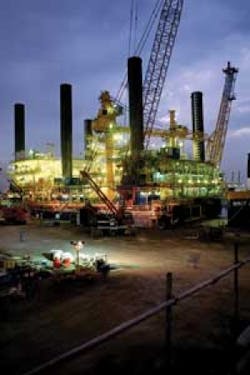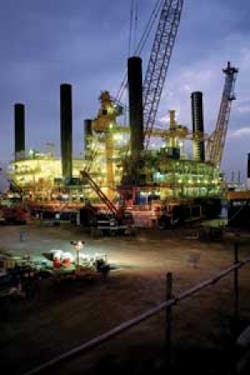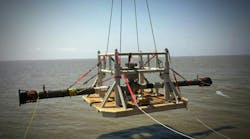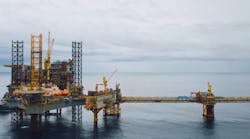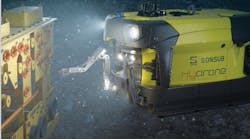Jeremy Beckman
Editor, Europe
UAE oil, gas, and energy services contractor, Maritime Industrial Services (MIS), is pushing hard for front-rank status. The company is targeting new markets in the Middle East and beyond to attain its goal of $1 billion turnover by 2013. This strategy of renewed growth is driven by EPC services, further penetration of the Abu Dhabi market, and building on newbuild expertise to focus on the renewable energy field. These form some of the key revenue streams that support the company’s position as providing a range of services.
Since its formation in 1979, the company has supported upstream and downstream oil and gas projects throughout the Arabian Peninsula, Iran, the Caspian region, and parts of North and West Africa. Trading links remain strongest with countries in and around the UAE.
“Our targets for expansion,” says Kevin Hudson, managing director, “include Abu Dhabi and Yemen, and establishing a bigger presence in Iraq.”
Around the time of its public offering in 2006, MIS drafted in new management - including Hudson whose background is shipbuilding and offshore construction in the UK and Canada - to restructure and take the company forward.
“When I arrived in 2008,” he says, “the company had already won contracts to build a series of seven jackups. Partly in preparation for this program, MIS increased its workforce from 1,200 to 5,000 people in the space of five years. That pace of growth demanded a different style of management – the newbuilding program, for instance, required cross-fertilization between the existing engineering and construction staff and the new ones we brought in from all over the world.
“My brief was to change direction and to take the company down a better strategic path. We have since restructured our value streams and our operations, curtailing some activities and expanding others. We have also undertaken a major investment to upgrade our IT infrastructure including software, hardware, and other processes and systems.”
Construction activities
For offshore oil and gas, MIS features rig building and refurbishment; fabrication of offshore structures, process modules and pressure vessels; structural, mechanical, and marine engineering; operations and maintenance activities; and engineering, procurement, and construction management (EPC).
The latter is handled by MIS’ newest division, Energy Projects International (EPI), headed by Murugesu Ramachandran, executive VP.
“We have always undertaken small EPC projects,” Hudson explains, “but mainly in the northern Emirates, using our presence in Sharjah as a stepping-off platform.
“Today there is a requirement throughout the Middle East region for EPC management capability, for contracts in the range $20-50 million. We decided to set up EPI, to capitalize on MIS’ expertise in EPC and to further penetrate the Abu Dhabi and neighboring markets.”
MIS has been refurbishing drilling rigs for 30 years, although newbuild construction is a recent development. The company also has engineered and fabricated a range of platform structures and, over the past 15 years, FPSO topsides modules. The track record during the past decade includes:
- Conversion of a jackup into a permanent processing facility for the BP/Anadarko Al Rayyan project off Qatar
- Construction, hook-up, and commissioning of a platform for Crescent’s Mubarak field offshore Sharjah
- Fabrication and pre-commissioning of five process modules for ExxonMobil’sXikomba FPSO in the Angolan deepwater sector
- A 2,600-metric ton Floating Storage and Offloading (FSO) module for SBM/Petronas Carigali for deployment offshore Turkmenistan.
Most major offshore construction is handled from MIS’ 200,000-sq m (239,198-sq yd) quayside yard in Port Khalid, Sharjah, where the company has a 3,000-strong workforce. Since 1998, a dedicated MIS team also has provided manpower and equipment support services for Dubai Petroleum’s offshore and onshore production assets.
The company also has operations in Kuwait, Qatar, and in Saudi Arabia via MIS Arabia, a jointly owned venture with AYTB and the Shoiabi Group. This facility, based in Jubail Port, recently underwent expansion including a newly covered 6,000-cu m (211,888-cu ft) workshop, a new 9 x 24 m (29.5 x 79 ft) post-weld heat treatment furnace, a blast room, and a paint shed. MIS Arabia typically fabricates heavy modules for refineries and desalination plants, but can handle offshore structures and subsea equipment, such as tie-in spools. Current work includes a fuel gas skid for Saudi Aramco’s Manifa offshore project, and Inconel 625 slug catchers for Aramco’s Karan offshore/onshore scheme.
As for new offshore construction programs around the Arabian Peninsula, Dubai Petroleum is inviting tenders for platforms for a recent oilfield discovery, and MIS is also bidding for the jacket for a new platform associated with expansion of oil exports from southern Iraq.
J Ray McDermott and NPCC tend to monopolize the large-scale construction awards off Saudi Arabia, Qatar, and Abu Dhabi, but as Hudson points out, there is also competition from yards in India and the Far East.
“It’s increasingly a question of price. A lot of the region’s recent onshore EPC contracts, for example, have been won by Korean companies. And if there’s a large-enough hull or platform to bid for, the Far Eastern yards would certainly come into the picture,” he says.
Rig deliveries
For MIS at present, however, the offshore construction focus has shifted to platforms, jackets, and well installations relating to renewable energy such as purpose-built wind farm installation vessels and the like, which use the expertise MIS has gained building jackups. Since winning its first newbuild orders in 2006, the company so far has delivered three rigs, with two more nearly complete. MIS states these are also the first new offshore jackup drilling rigs built by any yard in the Middle East.
In preparation for this activity, the company implemented a series of changes and investments at the Sharjah facility. According to Hudson, these included “an entirely new process layout, with new welding and fabrication shops and an introduction of the new work pack methods to improve efficiencies. We also brought in a 750-metric ton (827-ton) Manitowoc 18000 crawler crane – we had a range of cranes at the yard, but this one allowed us to erect the jackup legs earlier in the construction process.”
All new jackups are built to the Friede & Goldman Super M2 concept, which is based on the proven F&G L780 Mod II design for year-round harsh-environment operations in 300 ft (91 m) of water. The Super M2 is designed for all-year work in benign conditions, in accordance with ABS assessment criteria.
Prior to delivery, MIS classifies each rig as a numbered hull. The first two completed jackups, hulls 104 and 105, were delivered to Nigerian contractor Seawolf Oilfield Services in late 2008 and early 2009, and both have worked since offshore Nigeria.
Early this year KSAM2 Petrodrill Offshore, a joint venture between Singapore-based KS Energy Services, Saudi company Amwal Al Khaleej, and MIS, took delivery of the third completed jackup, the KS Endeavor (ex-hull 107).
MIS takes stakes in some of its own rigs, partly as an investment, Hudson explains.
“While our core competencies are in oil and gas contracting services, we want to add a repeatable revenue stream, which in the case of these jackups should continue for at least 30 years.”
However, security is another factor. In 2008, Cayman Island-based Mosvold Middle East Jackup (MEJU) commissioned two new Super M2 rigs, hulls 106 and 108. Last year, after MEJU ran into financial difficulties, a contractual dispute arose over payment, which led to MIS suspending work on the two newbuilds. Eventually, the dispute had to be settled by an arbitration process which saw MIS take ownership of hull 108.
Under the resolution the two parties entered into a new agreement for construction and delivery of hull 106 for $160 million. This stated that the $100.5 million, which MEJU had originally provided as an advance payment for the two rigs, would be entirely assigned to hull 106, with a further $30 million paid on the date that the agreement became effective, set for September 2010. The balance would be paid on delivery, or subject to an additional interest/arrangement fee, no later than June 30, 2011.
MIS will retain possession of the rig until all sums are paid under the new contractual terms. At that point, the two parties will withdraw all claims relating to the existing agreements for both hulls 106 and 108. MEJU (now Middle East Jack Up, as Mosvold is no longer part of the company) also will transfer legal ownership of hull 108 to MIS, which has already held discussions with potential buyers or partners concerning operational and financial support for this rig.
Last month, First Energy Bank, which contracted MIS for two jackups, issued a milestone payment of $25.79 million for theMENAdrill Hercules II (hull 110), which was launched off a barge at Dubai Drydocks in July. The MENAdrill Hercules I (hull 109) was loaded out in March. Even the delivered KS Endeavor I has not been paid for in full – a balance of $33 million is due by end-November – although in these two cases, the owners are financially sound. But the growing worldwide trend of some rig contractors defaulting has led MIS to enshrine in all its newbuild contracts the rights to retain or sell a rig in the event of non-payments.
This year MIS also secured its highest-value contract to date for a refurbishment program from Abu Dhabi’s National Drilling Co. for the jackupNDC Al Bzoom. The $55-millon Phase II Rig Integrity Assurance Program involves re-classification in accordance with the ABS MODU rules – this is a Baker Marine BMC-150-IC design rated for operation in water depths up to 110 ft (33.5 m), and a drilling depth of 18,000 ft (5,486 m).
Structural upgrades will include fabrication and installation of a new cantilever and derrick and other new drilling equipment; new spud cans, a new power system, and conversion to an electric jacking system. On completion early in 2011, the rig will sail out of Sharjah to drill oil wells on fields offshore Abu Dhabi.
“One technical challenge with refurbishment projects in general,” Hudson says, “is how to put increased value through an existing facility. How do you do it in a manner that avoids unnecessary re-work, or re-painting steelwork following welding? It is all about effective planning. Another challenge is how to achieve systematic completion, finishing a piece of work so that when you press the button, you can assume that it works. It’s definitely a learning curve.”
Lamprell, a competitor fabricator in the UAE which MIS works with occasionally on a sub-contract basis, has started building drilling semisubmersibles. MIS is not focused on this market, since accommodating semisubmersible hulls might requires a deeper quayside draft and given MIS’ focus on EPC and offshore platforms on the one hand and one renewable energy vessels on the other. At low tide, MIS’ Sharjah yard provides a draft of 8.5 m (28 ft), but Hudson points out that the company also has access to facilities at the Jebel Ali free zone, where there is a draft of 10 m (33 ft).
Offshore Articles Archives
View Oil and Gas Articles on PennEnergy.com
